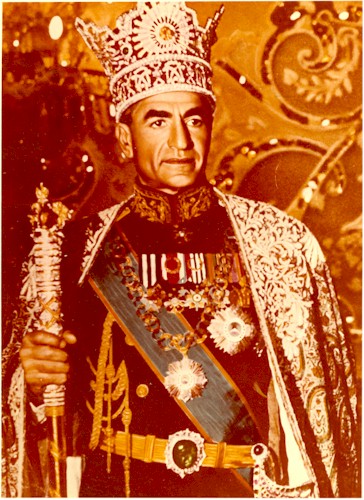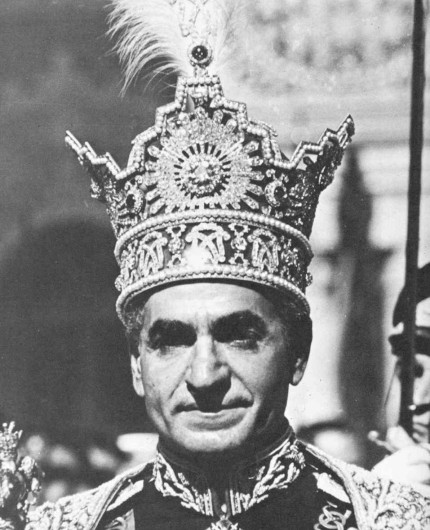

H.I.M. Mohammad Reza Shah Pahlavi

His Imperial Majesty Mohamed Reza Shah Pahlevi was born on the 26th October 1919, the son of the future Shah of Iran, Reza Shah Pahlavi, then a leading officer in the Qajar imperial army. Two years later, his father led a military coup and installed dictatorship, being elected hereditary monarch in 1925, what meant the end of the Qajar Dynasty and the installation of the new Pahlavi Dynasty. Upon his father’s coronation as Shah of Iran, he became His Imperial Highness The Crown Prince of Iran and was sent to Switzerland for studies, from where he returned in 1935 to attend the military academy in Teheran. He graduated in 1938. The following year, on the 16th March 1939, he married Princess Fawzia of Egypt, a sister of King Farouk.
Reza Shah Pahlavi abolished the British treaty in which Britain formally reaffirmed Iran’s independence but actually attempted to establish a complete protectorate over it. He reorganized the army, introduced many reforms, and encouraged the development of industry and education. In August 1941, two months after the German invasion of the USSR, British and Soviet forces occupied Iran. On the 16th September the Shah abdicated in favour of his son, who became His Imperial Majesty The Shahanshah of Iran.
The new Shah vowed to continue to reforms that had been begun by his father. Internationally he was know for his will of reformation but also for his personal life. On the 18th November 1948 he divorced Queen Fawzia, his first wife, who had given him a daughter, Princess Shahnaz. In 1949, he narrowly escaped assassination by a member of the leftist Tudeh party. On the 12th February 1951, in Teheran, he married Soraya Esfandiary Bakhtiari, thereafter known as Queen or Empress of Iran. Soraya was the daughter of HE Khalil Esfandiary Bakhtiari, Ambassador of Iran to the Federal Republic of Germany. In 1953 Their Imperial Majesties briefly fled the country after a clash with the supporters of Mohamed Mossadeg, but returned and the Shah formally became head of state again.

A moderate, the Shah launched in 1963 a major reform program with U.S. assistance, which he called the “White Revolution”. It included land redistribution among citizens, extensive construction, the promotion of literacy, and the emancipation of women. The Shah faced criticism from the internal religious clergy, who disfavoured his pro-Western policies. In 1966 the Imperial Household announced the Shah and the Shahbanou would be crowned the following year in Teheran. The coronation, held on the Shah’s birthday, 26th October 1967, was the most splendid imaginable and took the international press by storm. Four years later, Iran celebrated the 2500th anniversary of the Empire with an unprecedented party in Persepolis.
With the international crisis of the 1970’s affecting Iran’s relations with the World because of oil prices, and because of a sudden stop in the effect of the reforms, popular discontent grew. The opposition (extreme right and extreme left) got together to fight the Shah, and His Majesty began to loose control of the situation, leading the government to be less tolerant. Massive rioting erupted in Iran, and widespread support for the exiled religious leader Ayatollah Khomeini grew by 1978. The promises from exile were as miraculous as it is possible to imagine.
On the 16th January 1979, the Shah and the Imperial Family left Iran in what was thought to be a temporary exile. However, on the 11th February 1979, Khomeini took power and issued a death warrant against the Shah and his entourage. It was a condemnation which extended to all those who would give them hospitality or help them. The Shah and the Shahbanou were forced to leave the country without a definite destination for no land of haven had been suggested. Upon the intervention of the United States, the Bahamas Islands accepted to grant them asylum for only three months, on the condition that the Shah would refrain from taking any action or make any declaration. The imperial couple later went on to Mexico, where the health of the Shah, who had cancer, rapidly deteriorated.

The Shah was in dire need of a new surgical operation, but after having accepted American surgeons to operate the Shah on its territory, Panama recanted. The United States administration dispatched two envoys to let the Shah know that should he want to be operated in the United States, he would have to abdicate, at which time, President Sadat asked the Shah to come to Egypt. The sovereigns departed towards Cairo on the 23rd March 1980. At an Azores Islands stopover, some U.S. officials held the plane under the pretext of refuelling. All the while, they were apparently negotiating with the Islamic government procedures to return the aircraft to Panama. At long last, the Shah and the Shahbanou landed on Egyptian soil where President Sadat greeted them with utmost warmth, friendship and fraternity. In Cairo, they were able to see their children who had been studying in the United States and from whom they had been separated.
The Shah passed away in Cairo's Maadi hospital on the 27th August 1980. President Sadat organized official if not national funerals. The Shah's coffin, covered with the Iranian flag, was transported on a canon barrel with full military honours. In conformity to the Constitution, the Empress assumed the charge of the regency until the majority of her elder son. On the 31st October 1980, the Crown Prince reaching legal majority and swore under the holy Koran, to assume the responsibilities that the Iranian Constitution demanded from him, becoming, de jure, Reza Shah II of Iran.